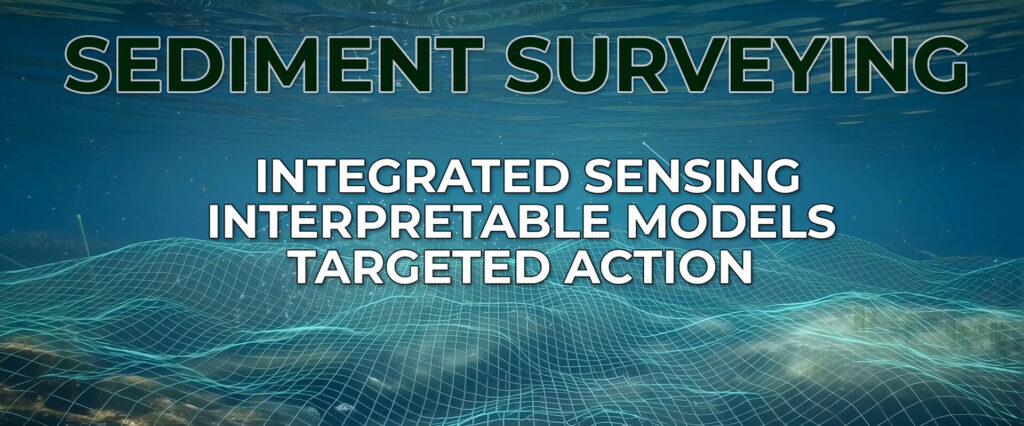Expert perspective for environmental planners, port and harbor owners, and marine contractors
Sediment intelligence directs better outcomes
Marine projects succeed when every stakeholder sees the same stratigraphy, interfaces, and quantities. Sediment surveying delivers that shared picture. By combining hydrography with geophysics and turning field data into an integrated digital geological model, teams gain precise boundaries for remediation, confident dredging templates, and production plans aligned to real materials. ARC Surveying and Mapping applies this approach on complex estuarine and harbor programs, translating layered measurements into decision‑ready maps and 3D views.
The toolkit as a system
Multibeam sonar and side‑scan imaging map the seafloor in detail and highlight debris fields or prior work that influences excavation strategy. Dual‑frequency lines complement multibeam for thickness checks in soft sediments. Aquares electrical resistivity resolves changes in material type and water content through the sub‑bottom, revealing the contact between native bottom and contaminants. These sensing layers are then fused with surface samples and core borings to create an ArcGeoTwin 3D integrated digital geological model (IDGM) that locates sediment interfaces and classifies material volumes. Deliverables arrive as AutoCAD and GIS drawings and shareable 3D viewers for rapid adoption in design rooms and field meetings.
What makes this stack powerful is orchestration. Each instrument contributes a distinct perspective; brought into a single georeferenced frame, the outcome is a coherent representation that supports permit exhibits, surgical remediation, and dredging quantity control.
How interpretation becomes action
An IDGM converts measurements into a working model. Color‑coded layers depict material classifications and interfaces. Cross‑sections show thickness and continuity of muck, sand, or rock. Correlated borings and chemistry attach provenance to every zone. The model functions as a live reference for planners and estimators, guiding equipment selection, excavation envelopes, capping footprints, and haul plans.
The advantage compounds in operations. Survey, geophysics, and borings travel together inside the same coordinates, so design updates, bid clarifications, and field markups all reference one source of truth. This single‑frame workflow keeps consultants, contractors, and agencies aligned from scoping through closeout.
Three projects that show the range
Bayou Chico, Escambia County FL A georeferenced program joined dual‑frequency hydrography with Aquares resistivity, then incorporated surface samples and core borings into an ArcGeoTwin 3D IDGM. The model depicted sediment layering and the interface between contaminated and native zones, enabling targeted excavation. A focused coring plan achieved the descriptions needed with fewer vibracores, which supported efficient planning and lab analysis.
Indian River Lagoon, Brevard County FL Aquares resistivity isolated muck zones and an ArcGeoTwin 3D interactive model displayed the interface with native bottom. Independent vibracore sampling validated the interpretation. Quantities and limits were derived directly from the model, and datasets were delivered in formats suited to bucket or hydraulic dredge systems, accelerating field adoption.
Port Everglades Sand Trap, Ft. Lauderdale FL Hydrographic, geophysical, topographic, and side‑scan surveys supported the design of an expanded sand trap and produced rock and sand excavation quantities. The enlarged trap is planned to intercept littoral drift before it enters the entrance channel, lowering maintenance frequency and creating a reserve for future beach renourishment. The geophysical model visualized sediment and rock layering alongside core boring locations.
Methods that turn precision into productivity
Sediment surveying excels when acquisition and interpretation are planned together. In practice, that means:
- Smart line plans. Hydrographic and resistivity lines are oriented to capture dominant gradients and cross critical interfaces, with adaptive infill where layer variability increases.
- Correlated evidence. Core locations and chemistry are registered inside the model so each color on a map ties back to factual samples.
- Actionable deliverables. Color‑graded layer maps, profiles, and 3D viewers translate directly into excavation envelopes, sequence drawings, and bid alternates.
This discipline turns complex stratigraphy into a simple set of next steps for permitting, procurement, and construction staging.
What owners and engineers gain
- Targeted remediation. Interfaces between contaminants and native bottom appear clearly, supporting surgical excavation and capping strategies that concentrate effort where it counts.
- Reliable quantities. Stratigraphic thicknesses and material types feed takeoff tables for realistic cost and schedule models.
- Integrated reviews. ArcGeoTwin models enable collaborative sessions where planners, regulators, and builders explore the same layers and cross‑sections.
- Field‑ready formats. AutoCAD and GIS deliverables slot into existing workflows for design submittals and construction coordination.
The takeaway
Sediment Surveying is most effective as a system: hydrography for detailed bathymetry, geophysics for subsurface characterization, borings and chemistry for ground truth, and an IDGM for synthesis. ARC Surveying and Mapping demonstrates how this integrated method produces clear boundaries, confident quantities, and models that guide action across remediation sites, harbor sand traps, and estuarine restoration corridors.

